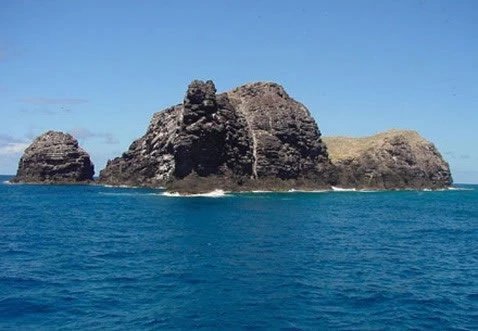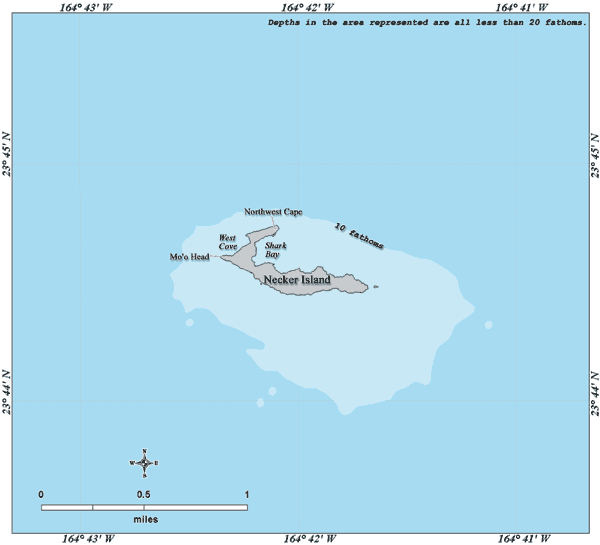Necker Island
Necker Island, or Mokumanamana, is a small, rocky outcrop in the Northwestern Hawaiian Islands known for its cultural and spiritual significance. Though barren and uninhabited, the island features over 30 ancient stone shrines, suggesting it once served as a ceremonial site. Today, Necker is protected as part of the Papahanaumokuakea Marine National Monument and is off-limits to the public to preserve its cultural and ecological integrity.

Located 155 miles (249 km) northwest of Nihoa and 430 miles (690 km) northwest of Honolulu, Necker Island (Mokumanamana) is a small (barely 41 acres), steep-sided, hook-shaped and barren volcanic island, quite unlike the tropical ideal of white-sand beaches and swaying coconut palms. Rainfall is less a little less than 25 inches a year and the only vegetation one can find here are low-growing shrubs and grasses. Necker Island is rocky and has very little soil. Its highest peak is 276 feet (84 m) and it encompasses 0.07 square miles (0.18 km²). It is one of the Northwestern Hawaiian Islands.
Probably because of its scarcity of natural supplies, few signs of any long-term habitation in the island's past have been found. However, there are 33 stone shrines on Necker Island and because of this, some anthropologists believe that Necker was a ceremonial and religious site.
It is believed that visits to Necker Island started a few hundred years after the Main Hawaiian Islands were inhabited and that habitation on Necker ended a few hundred years before European contact. The first European who visited Necker Island was French explorer Jean-François de La Pérouse, in 1786. The island is named after Jacques Necker. Because Necker Island was used by Native Hawaiians as a ceremonial and religious site in the past, the island was added to the National Register of Historic Places in 1988.
One legend from the island of Kauai, which lies to the south, tells that Necker Island was the last known refuge for the mythical "little people," the Menehune, who were chased off Kauai by the Polynesians and after that settled on Necker. They are believed to have built the stone structures there.

Frequently Asked Questions
Where is Necker Island located?
Necker Island lies 155 miles northwest of Nihoa and 430 miles northwest of Honolulu. It is part of the remote Northwestern Hawaiian Islands chain and belongs to the Papahānaumokuākea Marine National Monument.
Why is Necker Island culturally significant?
Necker Island contains over 30 ancient Hawaiian stone shrines, indicating its use as a ceremonial and religious site. These structures provide insight into early Hawaiian spirituality and navigation.
What kind of environment does Necker Island have?
Necker is rocky, dry, and barren with minimal vegetation, mostly low-lying grasses and shrubs. It receives under 25 inches of rain annually and has steep cliffs and volcanic rock features.
Can visitors travel to Necker Island?
No. Access to Necker Island is restricted to preserve its ecological and cultural integrity. A special permit from federal authorities is required for any research or educational visits.
Is there a connection between Necker Island and the Menehune?
According to legend, Necker Island was the last refuge of the Menehune - mythical "little people" of Hawaiian lore - who are said to have built some of the stone structures found on the island.















